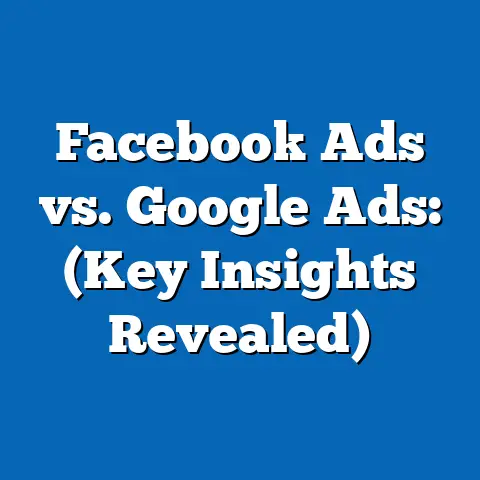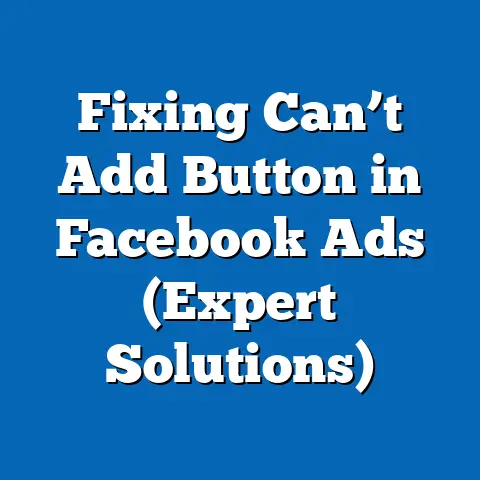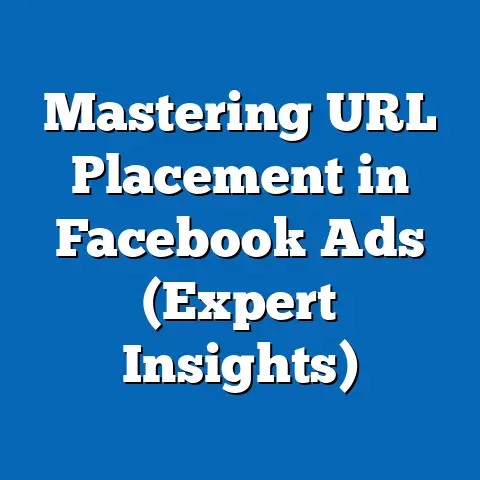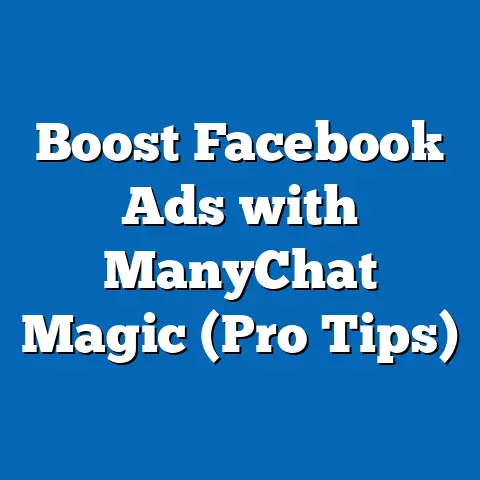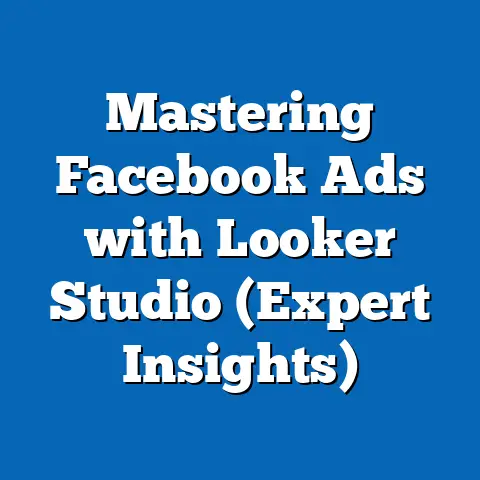Boost Facebook Ads Agency Results (Proven Strategies)
Facebook advertising has become a cornerstone of digital marketing, offering unparalleled reach and targeting capabilities. For agencies, mastering Facebook Ads is not just an option; it’s a necessity to thrive in a competitive landscape. I’ve seen firsthand how a well-executed Facebook campaign can transform a business, but I’ve also witnessed the frustration of wasted ad spend due to ineffective strategies. That’s why I’m excited to share proven techniques that can significantly enhance the performance of your Facebook ads, with a particular focus on the power of bold designs.
In this guide, I’ll walk you through the key elements that contribute to successful Facebook ad campaigns. We’ll explore how bold designs capture attention, how to craft compelling ad copy, the importance of precise audience targeting, the value of A/B testing, and how to leverage Facebook’s powerful ad tools. By the end, you’ll have a roadmap to boost your agency’s results and deliver exceptional value to your clients.
The Importance of Bold Designs in Facebook Ads
In the relentless scroll of the Facebook newsfeed, capturing attention is the first, and often the most difficult, hurdle. Bold designs are your secret weapon. Think about it: we’re bombarded with visual information every second. A subtle, understated ad simply fades into the background. A bold design, however, demands to be noticed.
What exactly constitutes a “bold design”? It’s more than just bright colors. It’s about using visual elements strategically to create an impact. Here are some key elements:
-
High Color Contrast: Using contrasting colors makes elements pop. Think a vibrant call-to-action button against a muted background, or a bold text overlay on a compelling image. I once worked on a campaign for a local restaurant, and we saw a 30% increase in click-through rates simply by switching from a pastel color scheme to a high-contrast palette of red and black.
-
Striking Typography: Forget generic fonts. Choose typefaces that are unique and legible. Experiment with different sizes, weights, and styles to create visual hierarchy and emphasize key messages. I remember a campaign for a tech startup where we used a bold, futuristic font that perfectly matched their brand identity and resonated with their target audience of young professionals.
-
Compelling Imagery: This is where you really grab attention. Use high-quality photos, illustrations, or videos that are relevant to your message and visually appealing. Avoid stock photos that look generic. Instead, opt for authentic images that tell a story and evoke emotion. I’ve found that user-generated content (UGC) often performs exceptionally well, as it feels more genuine and relatable.
-
Strategic Use of White Space: Don’t overcrowd your ad. White space (or negative space) allows your design to breathe and highlights the most important elements. A clean, uncluttered design is often more effective than a visually busy one.
High Color Contrast: Using contrasting colors makes elements pop. Think a vibrant call-to-action button against a muted background, or a bold text overlay on a compelling image. I once worked on a campaign for a local restaurant, and we saw a 30% increase in click-through rates simply by switching from a pastel color scheme to a high-contrast palette of red and black.
Striking Typography: Forget generic fonts. Choose typefaces that are unique and legible. Experiment with different sizes, weights, and styles to create visual hierarchy and emphasize key messages. I remember a campaign for a tech startup where we used a bold, futuristic font that perfectly matched their brand identity and resonated with their target audience of young professionals.
Compelling Imagery: This is where you really grab attention. Use high-quality photos, illustrations, or videos that are relevant to your message and visually appealing. Avoid stock photos that look generic. Instead, opt for authentic images that tell a story and evoke emotion. I’ve found that user-generated content (UGC) often performs exceptionally well, as it feels more genuine and relatable.
Strategic Use of White Space: Don’t overcrowd your ad. White space (or negative space) allows your design to breathe and highlights the most important elements. A clean, uncluttered design is often more effective than a visually busy one.
The impact of bold visuals on consumer behavior is significant. Studies have shown that people are more likely to remember and engage with visually appealing content. Bold designs can also influence brand perception, creating a sense of excitement, innovation, or luxury.
Key Takeaway: Don’t be afraid to be bold! Experiment with different visual elements to create ads that stand out from the crowd and capture attention.
Crafting Compelling Ad Copy to Complement Bold Designs
A stunning visual is only half the battle. You need compelling ad copy to seal the deal. Think of your ad copy as the voice that accompanies your bold design. It should reinforce the visual message, provide context, and ultimately persuade the viewer to take action.
Here are some strategies for writing persuasive ad copy:
-
Know Your Audience: Before you write a single word, understand who you’re talking to. What are their needs, desires, and pain points? Tailor your message to resonate with their specific interests. I always start by creating detailed buyer personas to guide my copywriting efforts.
-
Highlight Benefits, Not Just Features: Focus on the value you’re offering. Instead of simply listing the features of your product or service, explain how it will benefit the customer. For example, instead of saying “Our software has advanced reporting features,” say “Get actionable insights to optimize your marketing campaigns and boost your ROI.”
-
Use Strong Verbs and Action Words: Create a sense of urgency and excitement. Use verbs that encourage action, such as “Discover,” “Learn,” “Transform,” “Unlock,” and “Get Started.”
-
Keep it Concise and Clear: People have short attention spans. Get to the point quickly and avoid jargon or technical terms that your audience may not understand.
-
Create a Sense of Urgency or Scarcity: Encourage immediate action by creating a sense of urgency or scarcity. Use phrases like “Limited Time Offer,” “While Supplies Last,” or “Join Now Before It’s Too Late.”
-
Test Different Headlines and Body Copy: Don’t settle for the first draft. Experiment with different headlines, body copy, and calls-to-action to see what performs best.
Know Your Audience: Before you write a single word, understand who you’re talking to. What are their needs, desires, and pain points? Tailor your message to resonate with their specific interests. I always start by creating detailed buyer personas to guide my copywriting efforts.
Highlight Benefits, Not Just Features: Focus on the value you’re offering. Instead of simply listing the features of your product or service, explain how it will benefit the customer. For example, instead of saying “Our software has advanced reporting features,” say “Get actionable insights to optimize your marketing campaigns and boost your ROI.”
Use Strong Verbs and Action Words: Create a sense of urgency and excitement. Use verbs that encourage action, such as “Discover,” “Learn,” “Transform,” “Unlock,” and “Get Started.”
Keep it Concise and Clear: People have short attention spans. Get to the point quickly and avoid jargon or technical terms that your audience may not understand.
Create a Sense of Urgency or Scarcity: Encourage immediate action by creating a sense of urgency or scarcity. Use phrases like “Limited Time Offer,” “While Supplies Last,” or “Join Now Before It’s Too Late.”
Test Different Headlines and Body Copy: Don’t settle for the first draft. Experiment with different headlines, body copy, and calls-to-action to see what performs best.
The call-to-action (CTA) is the final, and arguably most important, element of your ad copy. It should be clear, concise, and visually prominent. Use action-oriented language, such as “Shop Now,” “Learn More,” “Sign Up,” or “Get a Free Quote.” Make sure your CTA button is visually distinct from the rest of your ad design.
I’ve seen countless examples of successful ad campaigns that effectively combine bold designs and compelling copy. One that sticks out is a campaign for a fitness app. The ad featured a vibrant image of someone working out, along with the headline “Transform Your Body in 30 Days.” The body copy highlighted the benefits of the app, such as personalized workout plans and expert coaching. The CTA button simply said “Get Started,” and it led to a free trial of the app. The campaign was a huge success, generating thousands of new users.
Key Takeaway: Your ad copy is just as important as your design. Craft compelling messages that resonate with your audience and drive them to take action.
Targeting the Right Audience for Maximum Impact
Even the most visually stunning ad with the most persuasive copy will fall flat if it’s shown to the wrong people. Audience targeting is the key to ensuring that your ads reach the individuals who are most likely to be interested in your products or services.
Facebook offers a wide range of targeting options, including:
-
Demographics: Target users based on age, gender, location, education, relationship status, and other demographic factors.
-
Interests: Target users based on their interests, hobbies, and passions. Facebook gathers this information from the pages they like, the groups they join, and the content they engage with.
-
Behaviors: Target users based on their online behavior, such as purchase history, travel habits, and device usage.
-
Custom Audiences: Create custom audiences based on your own data, such as email lists, website visitors, and app users. This allows you to retarget people who have already interacted with your business.
-
Lookalike Audiences: Expand your reach by creating lookalike audiences based on your existing custom audiences. Facebook will find users who share similar characteristics and behaviors.
Demographics: Target users based on age, gender, location, education, relationship status, and other demographic factors.
Interests: Target users based on their interests, hobbies, and passions. Facebook gathers this information from the pages they like, the groups they join, and the content they engage with.
Behaviors: Target users based on their online behavior, such as purchase history, travel habits, and device usage.
Custom Audiences: Create custom audiences based on your own data, such as email lists, website visitors, and app users. This allows you to retarget people who have already interacted with your business.
Lookalike Audiences: Expand your reach by creating lookalike audiences based on your existing custom audiences. Facebook will find users who share similar characteristics and behaviors.
Creating audience segments that are more likely to engage with bold ad designs requires a deep understanding of your target market. Consider their preferences, values, and lifestyle. Are they drawn to vibrant colors and edgy designs, or do they prefer a more subtle and sophisticated aesthetic?
I’ve found that precise targeting can dramatically improve campaign performance. For example, I worked on a campaign for a luxury watch brand. Instead of simply targeting affluent individuals, we focused on users who had expressed an interest in luxury watches, fashion, and travel. We also created a custom audience of website visitors who had viewed specific product pages. This targeted approach resulted in a significantly higher conversion rate.
Key Takeaway: Don’t underestimate the power of audience targeting. Take the time to understand your target market and create audience segments that are most likely to engage with your ads.
Leveraging A/B Testing for Design Optimization
A/B testing, also known as split testing, is the process of comparing two versions of an ad to see which one performs better. It’s an essential tool for optimizing your Facebook ad campaigns and ensuring that you’re getting the most out of your ad spend.
In the context of Facebook ads, you can A/B test a variety of elements, including:
-
Headlines: Test different headlines to see which ones capture the most attention.
-
Body Copy: Experiment with different body copy to see which messages resonate best with your audience.
-
Images: Test different images to see which ones generate the most engagement.
-
Calls-to-Action: Try different calls-to-action to see which ones drive the most conversions.
-
Targeting Options: Test different targeting options to see which audiences are most responsive to your ads.
Headlines: Test different headlines to see which ones capture the most attention.
Body Copy: Experiment with different body copy to see which messages resonate best with your audience.
Images: Test different images to see which ones generate the most engagement.
Calls-to-Action: Try different calls-to-action to see which ones drive the most conversions.
Targeting Options: Test different targeting options to see which audiences are most responsive to your ads.
Setting up A/B tests for ad designs is relatively straightforward. Facebook Ads Manager allows you to create multiple versions of an ad and split your audience between them. You can then track key metrics, such as click-through rate, conversion rate, and cost per acquisition, to see which version performs best.
Here’s a step-by-step guide:
-
Create a New Campaign or Ad Set: In Facebook Ads Manager, create a new campaign or ad set for your A/B test.
-
Duplicate Your Ad: Duplicate your existing ad to create a variation.
-
Modify One Element: Change only one element of the ad, such as the headline, image, or call-to-action.
-
Split Your Audience: In the ad set settings, choose to split your audience evenly between the two ads.
-
Run Your Test: Run your test for a sufficient amount of time (typically a few days or a week) to gather enough data.
-
Analyze the Results: Analyze the results in Facebook Ads Manager to see which ad performed better.
Create a New Campaign or Ad Set: In Facebook Ads Manager, create a new campaign or ad set for your A/B test.
Duplicate Your Ad: Duplicate your existing ad to create a variation.
Modify One Element: Change only one element of the ad, such as the headline, image, or call-to-action.
Split Your Audience: In the ad set settings, choose to split your audience evenly between the two ads.
Run Your Test: Run your test for a sufficient amount of time (typically a few days or a week) to gather enough data.
Analyze the Results: Analyze the results in Facebook Ads Manager to see which ad performed better.
Interpreting the results of your A/B tests requires careful analysis. Don’t just look at the overall numbers. Consider the statistical significance of your results. A statistically significant result means that the difference between the two ads is unlikely to be due to chance.
Based on the results of your A/B tests, make data-driven decisions about which ad designs to use in future campaigns. Continuously test and optimize your ads to improve their performance over time.
Key Takeaway: A/B testing is crucial for optimizing your ad designs and maximizing your ROI. Continuously test and refine your ads based on data-driven insights.
Utilizing Facebook’s Ad Tools for Enhanced Performance
Facebook provides a suite of powerful ad tools that can help agencies improve their campaign performance. Mastering these tools is essential for achieving optimal results.
Here are some key tools to leverage:
-
Facebook Ads Manager: This is your central hub for creating, managing, and tracking your Facebook ad campaigns. It provides a wealth of data and insights to help you optimize your ads.
-
Facebook Pixel: The Facebook Pixel is a small piece of code that you place on your website. It tracks user behavior and allows you to retarget website visitors with relevant ads.
-
Dynamic Ads: Dynamic ads automatically show the right products to the right people at the right time. They’re particularly useful for e-commerce businesses with large product catalogs.
-
Retargeting: Retargeting allows you to show ads to people who have already interacted with your business, such as website visitors, app users, or email subscribers.
Facebook Ads Manager: This is your central hub for creating, managing, and tracking your Facebook ad campaigns. It provides a wealth of data and insights to help you optimize your ads.
Facebook Pixel: The Facebook Pixel is a small piece of code that you place on your website. It tracks user behavior and allows you to retarget website visitors with relevant ads.
Dynamic Ads: Dynamic ads automatically show the right products to the right people at the right time. They’re particularly useful for e-commerce businesses with large product catalogs.
Retargeting: Retargeting allows you to show ads to people who have already interacted with your business, such as website visitors, app users, or email subscribers.
Facebook Ads Manager is your command center. Use it to track key metrics, such as reach, impressions, click-through rate, conversion rate, and cost per acquisition. Analyze the data to identify areas for improvement.
The Facebook Pixel is a game-changer for retargeting. It allows you to show ads to people who have visited your website, viewed specific products, or added items to their cart. This targeted approach can significantly increase your conversion rate.
Dynamic ads are a powerful tool for e-commerce businesses. They automatically show the right products to the right people based on their browsing history and purchase behavior. This eliminates the need to manually create ads for each product in your catalog.
I’ve seen numerous agencies successfully utilize these tools to boost their results. One example is an agency that used dynamic ads to promote a client’s online clothing store. By showing users ads for the products they had recently viewed on the website, the agency was able to increase sales by 20%.
Key Takeaway: Facebook’s ad tools are essential for optimizing your campaigns and achieving optimal results. Take the time to learn how to use them effectively.
Case Studies of Successful Facebook Ad Campaigns
To illustrate the power of bold designs and strategic implementation, let’s examine a few case studies of successful Facebook ad campaigns:
Case Study 1: Local Restaurant
- Challenge: A local restaurant was struggling to attract new customers.
- Bold Design Approach: The agency created a series of ads featuring mouthwatering images of the restaurant’s dishes, combined with bold, high-contrast colors.
- Strategies Used: The agency targeted local residents based on their interests in food and dining. They also used retargeting to show ads to people who had visited the restaurant’s website.
- Outcomes Achieved: The campaign resulted in a 30% increase in website traffic and a 20% increase in restaurant reservations.
Case Study 2: E-commerce Business
- Challenge: An e-commerce business was struggling to generate sales.
- Bold Design Approach: The agency created dynamic ads featuring high-quality images of the products, combined with bold headlines and compelling calls-to-action.
- Strategies Used: The agency used dynamic ads to show users ads for the products they had recently viewed on the website. They also used retargeting to show ads to people who had added items to their cart but hadn’t completed the purchase.
- Outcomes Achieved: The campaign resulted in a 25% increase in sales and a 15% increase in average order value.
Case Study 3: Tech Startup
- Challenge: A tech startup was struggling to raise brand awareness.
- Bold Design Approach: The agency created a series of video ads featuring visually stunning animations and a futuristic font.
- Strategies Used: The agency targeted young professionals based on their interests in technology and innovation. They also used lookalike audiences to expand their reach.
- Outcomes Achieved: The campaign resulted in a 40% increase in brand awareness and a 20% increase in website traffic.
These case studies demonstrate the power of bold designs and strategic implementation. By combining visually appealing ads with precise targeting, compelling copy, and the right tools, agencies can achieve impressive results for their clients.
Key Takeaway: Learn from successful case studies and adapt their strategies to your own campaigns.
Conclusion
Mastering Facebook advertising requires a multifaceted approach, but the power of bold designs cannot be overstated. Paired with effective ad copy, targeted audience strategies, A/B testing, and the utilization of Facebook’s tools, bold designs can lead to significant improvements in ad performance for agencies.
Remember to:
- Embrace Bold Designs: Don’t be afraid to experiment with different visual elements to create ads that stand out.
- Craft Compelling Ad Copy: Write messages that resonate with your audience and drive them to take action.
- Target the Right Audience: Ensure that your ads reach the individuals who are most likely to be interested in your products or services.
- Leverage A/B Testing: Continuously test and optimize your ads based on data-driven insights.
- Utilize Facebook’s Ad Tools: Master the tools that Facebook provides to enhance your campaign performance.
By implementing these proven strategies, you can boost your agency’s results and deliver exceptional value to your clients. The world of Facebook advertising is constantly evolving, so stay curious, keep learning, and never stop testing. Your next breakthrough campaign is just around the corner!


